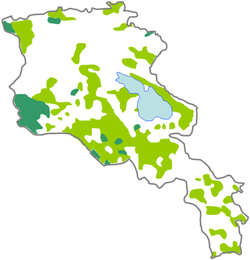Demographics

Approximately 98.1% of the country's population is ethnically Armenian, the vast majority of whom belong to the Armenian Apostolic Church. [1]
According to a survey done by the Pew Research Center, 51% of adults in Armenia are "highly religious", and the survey ranked Armenia as the second-most religious out of 34 European countries, after Romania. 79% of Armenians surveyed reported that they believe in God with "absolute certainty", and 53% consider religion very important in their lives. [3]
| Religion | Population (2011) [2] | Population (2022) [1] | ||
|---|---|---|---|---|
| Total population | 3,018,854 | 2,932,731 | ||
| Armenian Apostolic Church | 2,797,187 | 2,793,042 | ||
| Catholicism | 13,996 | 17,884 | ||
| Evangelicalism | 29,280 | 15,836 | ||
| Yezidism | 23,374 | 14,349 | ||
| Orthodoxy | 7,587 | 6,316 | ||
| Jehovah's Witnesses | 8,695 | 5,282 | ||
| Paganism | 5,416 | 2,132 | ||
| Molokan | 2,874 | 2,000 | ||
| Nestorian Church | 1,733 | 524 | ||
| Islam | 812 | 515 | ||
| Hare Krishna | - | - | 204 | |
| Judaism | - | - | 118 | |
| Other Protestant | 773 | 280 | ||
| Mormon | 241 | 85 | ||
| Transcendental meditation | - | - | 22 | |
| Other | 5,299 | 7,288 | ||
| None | 34,373 | 17,501 | ||
| Refused to answer | 10,941 | 49,353 | ||
| Unspecified | 76,273 | - | - | |

Geographic distribution
Yazidis are concentrated primarily in agricultural areas around Mount Aragats, northwest of Yerevan. They live in 19 villages in the Aragatsotn Province, two villages in the Armavir Province, and one village in the Ararat Province.
Armenian Catholics live mainly in the northern region, in seven villages in the Shirak Province and six villages in the Lori Province.
Molokans live in 10 villages in the Lori Province, two villages in the Shirak Province, and two villages in the Gegharkunik Province.
Most Jews, Mormons, followers of the Bahá'í Faith, Eastern Orthodox Christians, and Latin Catholic Christians reside in the capital Yerevan, which has attracted a greater variety of peoples. Yerevan also has a small community of Muslims, including ethnic Kurds, Iranians, and temporary residents from the Middle East. Foreign missionary groups are active in the country.








